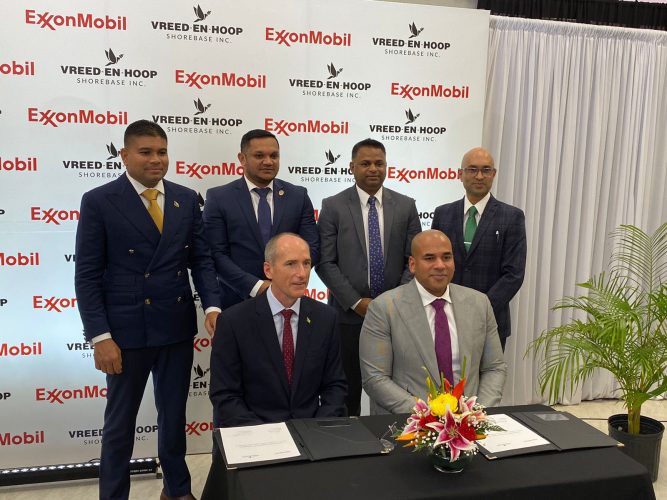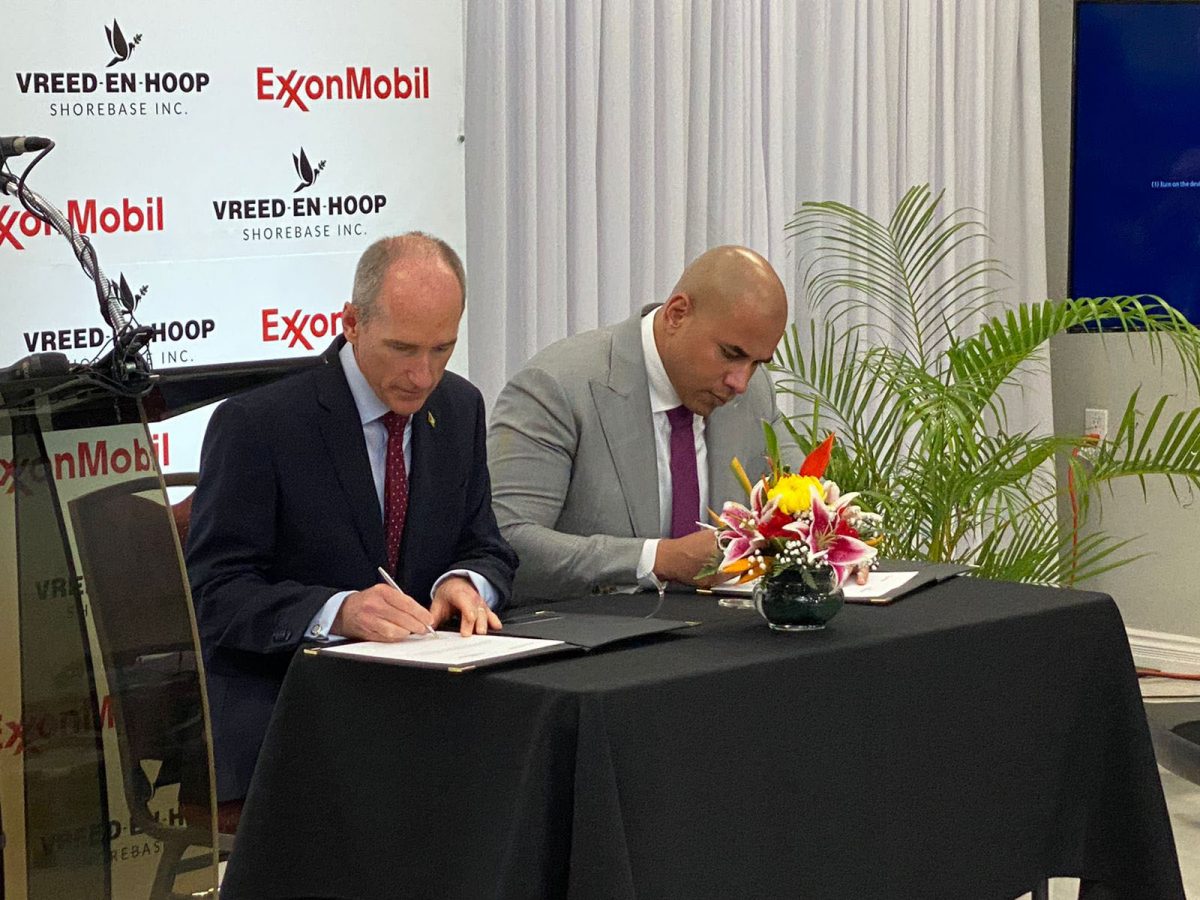Local consortium NRG Holdings Incorporated is poised to commence construction on its US$300 million shore base facility by next month, according to Director Nicholas Deygoo-Boyer.
The Vreed-en-Hoop Shorebase Inc (VEHSI) will be leased to ExxonMobil to support its offshore oil operations and the contract was signed yesterday by ExxonMobil Country President Alistair Routledge and NRG’s Secretary Andron Alphonso at Duke Lodge, Kingston.
NRG Holdings Inc is a consortium of three local entrepreneurs, comprising gold miner Andron Alphonso of ZRN Investment Inc; Nazar ‘Shell’ Mohammed, of HADI’S World Incorporated; and Deygoo-Boyer of National Hardware Guyana Ltd.

Last September, the Environmental Protection Agency (EPA) announced that it had granted an environmental permit to the company and stated that it would not require an Environmental Impact Assessment. Instead, the company had to submit an Environmental and Social Management Plan (ESMP) to the EPA within four months.
Deygoo-Boyer told the gathering yesterday that the company invested millions of dollars to conduct a plethora of geotechnical and other surveys to understand the impact of the project. He added that a “complete Environmental Social Impact Assessment” has been submitted to the EPA.
“…Millions of dollars [were] spent to know what is going on offshore…and when we did some of these studies, some of these data didn’t exist. I think we’re collecting flow data of the Demerara River up to the mouth and that data was not collected before. And believe me, we were grilled through the competitive (bidding) process,” Deygoo-Boyer said.
The initial project summary states that the project “is estimated to cost approximately US$200 to 600 million,” which shall include geotechnical and environmental studies, engineering works, dredging operations, reclamation, and the construction of a wharf, storage, warehouse, and safety facilities.
“The project will see an investment of up to US$600 million by the 100-per cent Guyanese-owned consortium,” the group had said in a statement.
Deygoo-Boyer told reporters that the project is expected to generate some 300 jobs during the construction phase. He said that the construction methodology is heavy equipment-based, so there will be a demand for operators and equipment movers. He added that more jobs will be created during the operation phase of the shore base that would depend on the demands of Exxon, which will be the operator of the shore base.
He further explained that VEHSI is a sub-project of the Port of Vreed-en-Hop masterplan and 85% of the stakes are owned by Guyanese. The other 15% is held by the contractor Jan De Nul Group. The facility will occupy some 400 hectares of coastland.
Deygoo-Boyer explained that the consortium was invited, by ExxonMobil, to bid for the project a few months after it was formed. He described the process as a gruelling one.
“Our bid was to design and build. In other words, you’re pitching a completed project. [We chose to partner with Jan De Nul] because it is one of the best in the world,” he said while adding that the company assisted NRG to conceptualise and finding financing for VEHSI.
With construction expected to commence next month, NRG has promised to deliver a completed facility to Exxon by the fourth quarter of 2023. The facility will be heavily focused on aiding Exxon’s construction and fabrication efforts.
Deygoo-Boyer said that the contract with Exxon is a “kick-start” in the right direction for the consortium. He added that there have been claims in some quarters that financial backing for the project was received from the government but dispelled those rumours.
“Our support from government — which we appreciate the support we received [but] — that support has been around leasing us the premises based on our development and giving us the permits needed to do this. There is no financial support [from the government]. This is entirely a private initiative and that means that the risk capital is being borne by the developers and the entrepreneurs or partners,” he said.
He added that the project is also not a “get rich quick scheme” since the return on investment timeline is not in the near future.
Springboard
Meanwhile, Exxon’s President Routledge said that the development of Guyana’s oil and gas sector is unprecedented, explaining that moving from discovery in 2015 to approval of its fourth development within a seven-year period is relatively fast.
He noted that VEHSI is an important project because it would enable investors in the oil and gas sector to do more. He, too, spoke of the process being a highly competitive one that took commitment.
Routledge said that VEHSI’s role will be different from that of Guyana Shore Base Incorporated (GYSBI). GYSBI is Guyana’s first shore base facility and has enabled Exxon to move almost all of its supply chain for drilling and production operations from Trinidad to Guyana.
“What VEHSI allows us to do is to bring more of the construction activities, the preparation for installation of subsea equipment. Everybody tends to focus on the vessel that’s on the surface – the FPSO, but we put just as much investment on the seabed and into wells,” he said.
He added that some of the fabrication of jumpers and steel plates to go on the seabed to connect the wells are being done in Guyana at a smaller facility – SAIPEM area – but with VEHSI coming on board that would increase capacity significantly.
“…capacity to do more construction and assembly work will truly be a springboard for the Yellowtail [Development Project] and future projects to increase local content for what we do in the oil and gas industry,” Routledge said.
Yellowtail was granted its environmental permit on March 30 and its production licence two days later by the EPA and Ministry of Natural Resources, respectively, and is touted as Exxon’s largest project, to date, in Guyana. The investment is pegged at US$10 billion.
As part of the Yellowtail Project, ExxonMobil plans to drill between 45 and 67 wells for the 20-year duration of the investment. It is intended to be the largest of the four developments with over 250,000 barrels of oil per day targeted once production commences. Based on the schedule, once approval is granted, engineering commences this year and production in the latter part of 2025.
Routledge says that with the VEHSI located in Region Three (Essequibo Islands-West Demerara), it shows that investments are expanding beyond Region Four (Demerara-Mahaica). He also referenced the gas to energy project slated for the West Demerara, for which Exxon recently submitted its Environmental Impact Assessment to the EPA for approval.
Minister of Natural Resources Vickram Bharrat also addressed the gathering and said that government welcomes such development.
A number of senior officials from Region Three’s government and private sector were at the signing.






